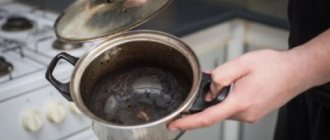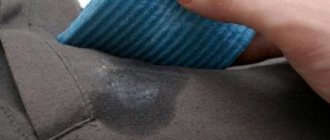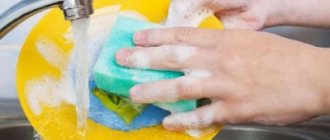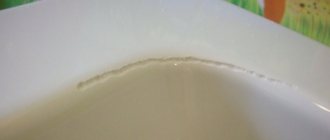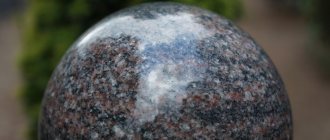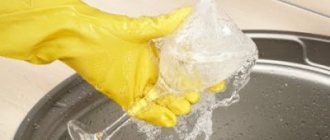Keeping the toilet clean is not difficult if you know exactly how to deal with the most common problem - urinary stones on the walls of the toilet.
This dirty yellow coating on a snow-white surface not only spoils the appearance of plumbing fixtures, but is also a breeding ground for many pathogenic bacteria that are dangerous to human health.
How to remove urinary stones in the toilet if there is water there, including old ones? There are a sufficient number of folk methods and types of household chemicals that can make the process of removing urinary stones quick and as effective as possible.
How to clean a children's plastic potty from urinary stone deposits?
If you wash the pot thoroughly immediately after using it for its intended purpose, then no plaque will have time to form.
If it has formed, then Domestos cleans it up quite well. It is also good for disinfection. The pot should be disinfected periodically, so I am for Domestos. The main thing is to wash it off thoroughly afterwards, it still contains chemicals.
I found an interesting way to clean a child’s plastic potty from plaque. If you pour water into it that has just boiled in a kettle, then the high temperature will cause the plastic to begin to expand, and the plaque will bounce off the walls.
There is an excellent tool, quite inexpensive. Sold in almost all hardware stores. It's called Chistin. Turns urinary stone into jelly and is easily washed off with a stream of water. Eliminates the problem of scraping. Does not damage the surface, even plastic.
I asked myself this question and researched Google. What I tried: Domestos, Sanox, whiteness, duckling for cleaning toilets - the result was little. The following recipe helped:
- lemon acid. Sprinkle the whole bag evenly over the stone at the bottom of the pot.
- boiling water. Pour boiling water to the point where the urinary stone deposit ends.
- leave for about a couple of hours. Then scrub the stone with a stiff brush (possibly with force). Be sure to clean the pot with gloves, because the acid is very concentrated and burns the skin on your hands.
It helped me. I hope this method will help you too. The recipe is also suitable for cleaning plastic cat litter.
You can use the same product you use to clean the toilet. I sometimes add a small amount of product to the brush container and the product does not corrode the plastic. The main thing is to rinse it thoroughly so that the product does not remain and the child cannot come into contact with it.
Removing plaque with vinegar is a good option, but it takes a long time. You can speed up the process by using hot water, but then the smell will be much more intense.
You can try organic products, for example from Klar. But they cannot be called safe; the product is made on the basis of lactic acid.
But I haven’t come across any special products for children, as is the case with washing powders or fabric softeners.
Removing old dirt
An electrolyte is effective in removing urinary stones that have accumulated over the years. You should work with it carefully, wear gloves and goggles, and apply it carefully without splashing. It will quickly dissolve the thick layer of stone inside the toilet, but can damage the sewer line made of plastic pipes.
If the toilet has not been cleaned for a long time, oxalic acid powder will help remove deposits. It is applied to a moistened sponge and removes dirt. You can sprinkle acid on the stains and leave for an hour. After completion of work, its residues should be thoroughly washed off.
To clean the toilet of dense deposits, first of all, they must be softened. The selected product is applied to the stains, left for several hours, after which it is cleaned with a fiber sponge, which is harsh on the surface. Some are difficult to achieve and the procedure has to be repeated. Housewives often use the following folk remedies to clean stone from plumbing fixtures:
- 1 cup 9% vinegar mixed with 1 tbsp. l. soda;
- citric acid powder or dissolved in water.
When does a urinary stone appear and how to remove it?
Most often, deposits on the walls of the toilet are found in crowded apartments, where there is one bathroom for several people. An ugly and foul-smelling coating on the walls of the toilet does not appear immediately, but growths are sure to form. Unless, of course, you take preventive measures :)
Therefore, removing a urinary stone will take a minimum of time if you pour half a glass of “Belizna” (a household bleach solution for bleaching clothes and disinfection) into it once a week for 1-2 hours. Don't forget to close the toilet lid - the smell of bleach spreads quickly. Then all that remains is to drain the water after an hour or two, carefully remove the deposits with a wooden stick and forget about this unpleasant procedure for a week or two.
But if you got a neglected plumbing fixture or the owner was absent from the house for a long time and no one looked after the toilet, then more drastic measures are needed.
When an acrylic bathtub can no longer be saved
If the yellow coating appears due to exposure to caustic cleaning agents or “jambs” during restoration, it will most likely not be possible to bleach the acrylic bathtub. In 85% of such cases, the coating has to be restored.
How to Prevent Chemical Damage to an Acrylic Bathtub Cover
Note: aggressive acidic agents with a pH of 2-4 destroy the coating of an acrylic bath gradually: after 1-3 uses you are unlikely to notice a change in color. A yellow coating may appear only after 5-6 months of regular use of a caustic cleaner.
Note: with age, acrylic becomes vulnerable to dyes that are included in the composition of some cosmetics and cleaning products. Dyes quickly attach to the surface of the bath and are extremely difficult to remove. If colored spots appear on the surface, try cleaning them with whitening toothpaste.
How to clean a toilet from urinary stones
Do not try to scrape with an iron mesh or a brush: the process is long, the metal leaves traces on the sanitary ware, and it will not be possible to completely get rid of the build-up.
You can dissolve urinary stones that have built up over a long period of time in several simple ways:
- The most effective one has already been described - pour bleach. To improve the effect, repeat the procedure until the urinary stone is completely removed. A small note: if the housewife is in an “interesting situation,” then the bleach method cannot be used.
- Pour ½ pack of baking soda ash overnight. It is washed off in the morning in several steps, but it works well. Provided that no one used the “night vase” during the entire procedure.
- Pour a bottle of Coca-Cola or Sprite (1.5 l) into the toilet at night. The citric acid and carbon dioxide contained in these drinks “eat up” unsightly growths on the walls of the toilet. How it works - see the video at the end of the article.
Save so you don't lose!
Please note: there are tips to clean the toilet from urinary stone using very exotic methods - pour in heated vinegar (think what will happen to the enamel after scalding) or electrolyte from under the battery (the plastic corrugation to the toilet will not hold up, and the sewer riser will be in danger of leaking) , add oxalic acid (destroys enamel) and other methods. Don't take risks. A toilet is an expensive device, and replacing it requires financial costs. Just try one of the above methods. It will definitely work, checked :)
And another little tip: if your toilet brush cup closes tightly, pour a little bleach (“White”) into it. This will ensure the cleanliness of the cup itself, the brush and will disinfect the toilet every time you use this brush.
I will be grateful if you press the buttons :)))
Cleaning process
Whatever solution you choose to clean the toilet from urinary stones, first of all you need to drain the water seal. This can be done by putting water into an enema or plastic bottle with a tip. Collect it with a sponge and rag. After this, all contamination and the scope of work will appear in full. You may find that urinary stone in the toilet, in the corners of the drain hole, is as thick as a finger. If everything is not so bad as to clean the toilet from plaque, apply the detergent for an hour, then rub it with a brush and rinse it off.
Alkaline products (Belizna, Domestos) or acid-based products (Silit Beng toilet gel) dissolve urinary stones. For medium-intensity pollution, apply the selected product for 6-10 hours. To clean the rim, moisten paper napkins and place them on the stains.
All of the above products are also suitable for removing limescale, which is formed from the minerals contained in the drain water. The more often you flush, the greater the likelihood of accumulation. The sediment gradually eats into the surface of the plumbing, making it rough. To remove plaque in the toilet using home remedies, try the following remedy: apply 0.5 liters of Coca-Cola to problem areas, leave for 2-3 hours and remove the dirt with a brush.
You can remove stone from a toilet without removing the water from it. If the formations are not very dense, try using concentrated Antikalk powder. The product must be added to the drain hole (1-2 tablespoons), and after the reaction is completed (after about 20 minutes), clean it. If you have Antikalk in liquid form, you will need at least 500 ml.
To prevent the formation of plaque and stone, you can purchase special tablets for toilet tanks. Depending on the concentration of active ingredients and the number of rinses, 1 tablet removes signs of plaque within 2-8 weeks.
The selected product is applied to the stains, left for several hours, after which it is cleaned with a fiber sponge, which is harsh on the surface.
How to safely clean a child's potty from plaque
At first I used this powder in two cases:
- Conservation
- Descaling kettles
Why did you use it? Because there is a child in the house! And because of this, I don’t want to use vinegar essence.
I canned tomatoes. They stood perfectly, did not explode.
And she cleans teapots perfectly!
The information was from the instructions for the thermopot.
Pour 40 g of citric acid into a full thermopot, boil, let stand for 15 minutes, boil again and drain. Rinse inside. You can boil water for tea.
I filled up the whole package.
And then I thought, why not clean the pot with lemon.
I don’t want to scrape it off, there will be scratches, the five-year coating is not washed off in the usual way, I don’t want to use chemicals yet, it’s not porcelain. Damn, that's something I didn't think of before.
Here you go. That's how I am. opponent of unsafe chemistry.
This is what he looked like:
Pour in hot water, add acid and leave for 15 minutes.
the ice has broken, gentlemen
So now I know how to restore the pot to its original form.
It’s a pity we’ve run out of acid at home, we won’t be going to the store so soon, so I’ll add a photo later.
But the result is already quite obvious.
It is clear that it will clean to a shine.
In general, I recommend it!
Net weight: 50 g
I hope that my review was useful to you in some way.
Come visit, maybe something will interest you
Symptoms in a child aged 2 years
At 2 years old, the body is still very delicate, and the slightest disturbance in nutrition, treatment, etc. can cause very serious illnesses. Therefore, the reasons for the appearance of sediment can be very different, most often taking medications during illness.
Dehydration at this age is rare, physical fatigue is also rare, but in case of illness, some mothers like to independently prescribe medications to their children that affect the kidneys and liver (sulfonamides, antibiotics). The result is the appearance of insoluble sediment in the urine.
Simple ways to clean a child's potty from plaque
There are simple ways that make life easier for mothers all over the world. So, below are these ways to clean a pot from plaque.
Melamine sponge
The new invention is already on sale in almost every household goods store. The melamine sponge not only copes well with kitchen stains, but also cleans other surfaces.
To wash off the plaque, you need to pour boiling water over the pot and let it sit for 10-15 minutes. After this, drain the water and rub until you get the result. The melamine sponge does not need to be washed or wet during the cleaning process - this will reduce its effectiveness.
Citric acid
Citric acid is not absorbed into plastic and other materials, and is not toxic, so it can be safely used in the fight against plaque. This method is based on chemistry - acids corrode salt deposits and after soaking, the plaque is easily removed with a regular sponge.
It is important to thoroughly wash the pot under running water, as acid residues can cause skin burns or cause an allergic reaction. Citric acid is not always safe for plastic - some products with poorly fixed dye may lose their color.
Vinegar essence or table vinegar
Vinegar essence is used to quickly clean the pot. If you have more time, it is better to use regular table vinegar.
It is necessary to fill the pot with table vinegar and leave overnight. In the morning, add 2 tablespoons of soda, let it react and wash away the soft traces of plaque with a sponge.
Boiled water
Important! This method is only suitable for cleaning thermoplastic products that can withstand high temperatures without deformation. So, the mechanism of the method is extremely simple - it is based on ordinary physical phenomena. Essence:
- the pot is washed and cooled with ice or ice water;
- pour boiling water into an empty pot;
- leave for 3-6 minutes;
- As a result of temperature changes, the plastic walls begin to expand rapidly, and the plaque layer is destroyed.
After this manipulation, you can wash the inner surface, and if not everything is wiped off the first time, repeat the same manipulation several times.
Plumbing cleaner
It is not advisable to use household chemicals in the care of children's accessories. But in extreme cases, they can be used on the condition that the product is thoroughly washed and rinsed. Products for cleaning plumbing fixtures from limescale are just as effective in removing stone deposits on the walls of a child’s potty. Action plan:
- apply to a dry surface;
- stand for 15-20 minutes;
- clean with a regular sponge;
- Rinse under running water until traces of the chemical are completely removed.
On a plastic surface, this product is no less effective than on tiles, metal and other plumbing products. The only negative is that chemicals can eat into the plastic and in order to get rid of them you can rinse the pot with a weak solution of soda.
Causes of sediment
Sediment in the urine occurs due to the following reasons:
- Insufficient kidney function during periods of heat and dehydration;
- Excessive physical activity (especially important for children, because they get overtired very often);
- Loss of fluid due to diarrhea or vomiting;
- Leukemia (a very dangerous disease);
- Diabetes;
- Intestinal diseases;
- Poisoning;
- Cystitis;
- Intestinal diseases (also often found in children who are not accustomed to hygiene).
As you can see, there are a huge number of reasons, and in order to establish the true reason, you must definitely contact specialists .
Using a Steam Cleaner
This modern device is designed to clean various surfaces by dissolving and melting dirt under the influence of a powerful jet of steam. The device comes with attachments, including those specifically designed for the toilet. Using the rounded one, you can direct a stream of steam under the rim. The brush attachment is convenient for simultaneously softening and removing urinary stones. Additionally, the temperature of the steam speeds up chemical reactions, making the toilet cleaner more effective. Cleaning not just the toilet, but the entire bathroom with a steam cleaner is quick and easy. You can avoid using detergents at all when cleaning or use less of them. Steam penetrates everywhere, knocks out dirt and disinfects. After this, all surfaces should be wiped dry. A toilet that is cleaned with a steam cleaner never has any unpleasant odors.
Contamination inside the toilet appears systematically, so basic cleaning must be carried out constantly. It’s easier to do this every day for 5 minutes than to then kneel in front of it for half a day, rub and scrape, or go get a new one. It’s not difficult to train yourself and your family to keep the plumbing in your home clean and well-maintained.
Soak seedling pots in bleach solution
To disinfect ceramic and clay pots for growing seedlings, thoroughly wash them to remove soil and organic matter and soak them in a solution of one part household chlorine bleach to 9 parts water for at least 10 minutes. It is convenient to work in a bucket, as you will need less working solution. Then dip in dishwashing detergent and rinse. To remove mineral deposits and other debris from clay pots, use a wire brush. Scrape off any remaining mineral deposits with a knife.
Rinse the pots thoroughly and soak them in a bucket of clean water.
Dry well, group by size and place in neat piles in a clean, dry place, such as a greenhouse.

